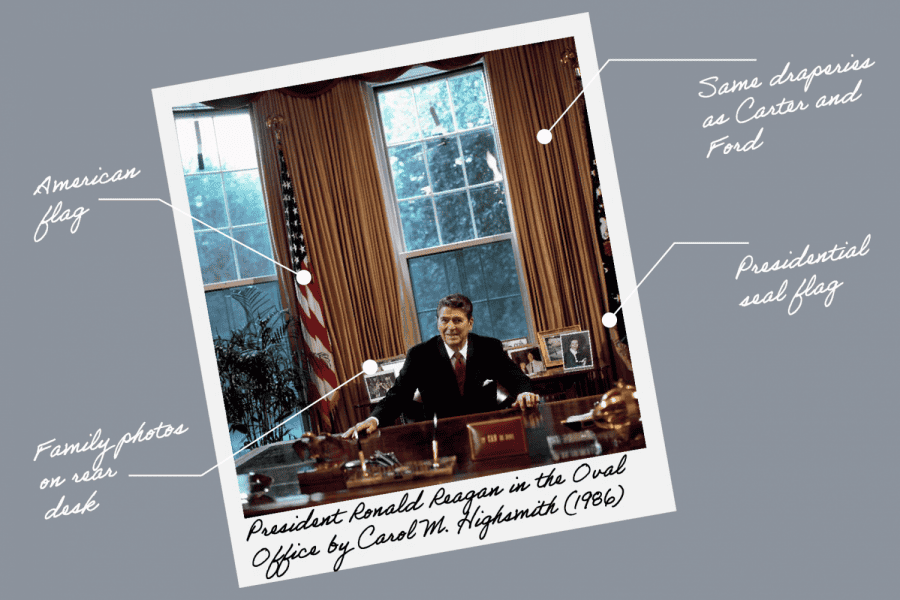Inside Biden’s White House and the symbolism of Oval Office design
From the carpeting to the portraits on the walls, the Biden administration’s decor decisions highlight his goals for the office.
Photo courtesy of the Library of Congress.
February 24, 2021
It’s been a month since President Joe Biden took office, and we’re finally getting what we’ve all been waiting for: Biden White House dog content.
On Feb. 23, the official @POTUS Instagram and Twitter accounts posted a photo of Biden and his German shepherds Major and Champ in the Oval Office.
“Not many people have Oval Office walk-in privileges,” the caption read. “Happy to report that these two are on the list.”
But a lot of unseen work went into making the Oval Office home for Biden and his dogs, all of which occured in mere hours on Jan. 20, while Biden was being sworn in.
“There’s a fascinating tradition of how the White House is switched over from one administration to the other, and a lot of behind-the-scenes stories that often don’t come out for years,” said Ian Crawford, an interior design instructor at the University. “It’s almost like a theatre set to completely switch, because the outgoing president is president until noon on Inauguration Day… and it is still their office and residence.”
By the time the new first family arrived at the White House in the afternoon, everything from the carpet and furniture to the art and decor had been modified to suit their tastes. Photographers were invited into the Oval Office to document the president’s first day in office, and that first look at the new White House was crucial in setting the tone for Biden’s presidency.
“This Oval is an Oval for Day One,” Ashley Williams, deputy director of Oval Office operations told the Washington Post on Inauguration Day. “It was important for President Biden to walk into an Oval that looked like America and started to show the landscape of who he is going to be as president.”
Biden did make many noticeable changes, including replacing former President Donald Trump’s light-colored patterned carpet, also used by former President Ronald Reagan, with an unpatterned deep blue carpet last seen in former President Bill Clinton’s Oval Office.
Crawford, who has taught courses on White House material arts and is a former executive director of the Tuscaloosa County Preservation Society, said the new carpet may be a nod to the Democratic Party, but also establishes a shift to simplicity in the design of the room.
As an example of decluttering, Crawford pointed out that Biden removed the military flags that were displayed during Trump’s term, opting for the simpler, traditional use of just the American flag and the flag bearing the presidential seal.
In fact, Crawford said the new look of the Oval Office is highly traditional, likely in response to the ongoing COVID-19 pandemic.
He referenced other times of crisis in American history, like President William McKinley’s assassination and 9/11, when contemporary stylish design in the White House was replaced with traditional furniture and decor to evoke feelings of safety and familiarity.
Biden also chose to display a collection of family photos behind his desk, which Crawford said portrays his strong family values and may also be reassuring to Americans at a time like this.
“You have tradition and you have personal choice, and the Oval Office is the nexus point of that, because it is the presentation office of the president and the presidency, but it is in the administrative section of the White House,” Crawford said.
However, Crawford said the artifacts and design choices we see now may well be replaced or modified over time.
“I think that we’re going to see accomplishments represented in things being added to the Oval Office,” Crawford said. “When somebody comes in, they’re a new president, so they have things that they’re looking forward to and they have their role models up. So you see there’s Dr. Martin Luther King Jr.’s bust on display, Franklin Roosevelt[’s painting] and other people [represented] who dealt with adversity and dealt with crises in American history… We’re going to start to see some other items coming in, but at the beginning what we’re seeing is a view and an open display of who the role models are and who we’re emulating in a new administration.”
A bust of Martin Luther King Jr. is one of several in the room, alongside fellow civil rights activists such as Rosa Parks and Robert F. Kennedy.
On his first day in office, Biden signed an executive order instituting plans for racial and social justice reform, which he had promised during his campaign.
A painting of former President Franklin D. Roosevelt, who led the country during the Great Depression, hangs above the fireplace, alongside paintings of former presidents George Washington, Abraham Lincoln and Thomas Jefferson and former Treasury Secretary Alexander Hamilton.
“The rearranging of portraits really tells a story, so I was very interested to see that it’s not a single portrait above the mantel, which is what we’ve seen recently, but it’s rather a group of portraits over the mantel,” Crawford said. “I think that’s very interesting, very much by design and telling, so that it is [saying] government is not just one person, it’s several… Government is by the people, and here’s the sort of people that it’s come from.”
The decision to display the portraits of Jefferson and Hamilton next to each other holds even deeper symbolism.
“[Biden] put Thomas Jefferson and Alexander Hamilton right next to each other by the fireplace, and those are people who historically had major differing views,” said Brighton Ellisor, a senior majoring in interior design. “I think it kind of shows that there’s a greatness in difference… also overcoming that difference and acknowledging and accepting each other where we are, and just moving forward for that and for the greater good.”
Biden has been vocal about the need for bipartisan cooperation and action and has repeatedly promised to be a president for all Americans, not just those who voted for him.
The pieces of artwork Biden has chosen to display represent his priorities and goals for his term, as well as past leaders he hopes to emulate.
According to the White House Historical Association website, Congress is tasked with appropriating funds for renovations and repairs in the White House, which are then overseen by the Committee for the Preservation of the White House.
Meanwhile, the furniture, carpets, artwork and other artifacts used by each administration belong to the White House Collection, along with hundreds of other items that are rotated between the White House and storage.
Ellisor said the design of a space should embody its owner, and in a room like the Oval Office, which people are continually moving in and out of over time, it’s even more important for each president to customize the space.
“I think especially during COVID-19, we’ve seen [that] working from home, you want to be comfortable in your space and have it allow you to work in the best way that you can,” Ellisor said. “I think by each president changing the room, it just shows a representation of who they are and how they work best, and also makes it inspire them.”





















